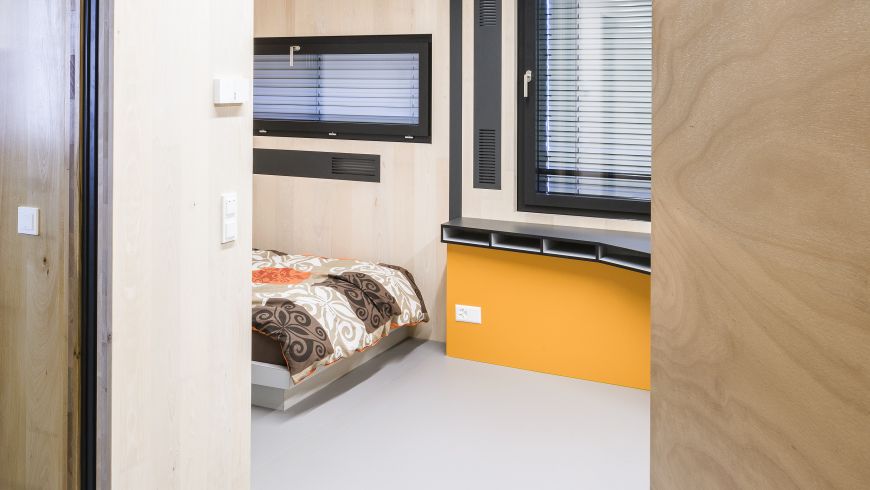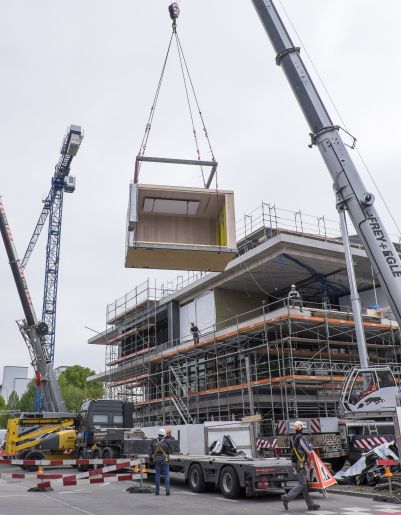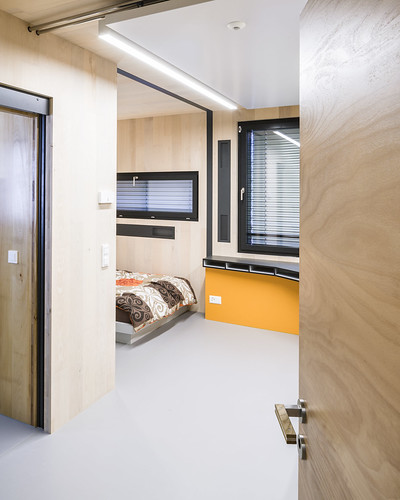NEST-Unit "Vision Wood"
The fascination of wood

Many people dream of living in a wooden house, but after a few short years the exterior is already weathered and faded. Even when used inside, the material is very sensitive, fading in direct sunlight and warping under potted plants if your neighbor overwaters it while you are away on holidays. It takes a lot of effort to maintain a house like this. Regular sanding and varnishing is needed, unless you want to tear down your patio and rebuild it every five years. Wood is nevertheless the preferred material of many people because it is attractive to look at and strong and simple to work with, making it ideal as a material for construction.
New inventions put to the test in real life
In order to make wood easier to care for and thus (even) more attractive as a material for building, Tanja Zimmermann, Head of the Empa department “Applied Wood Materials”, and Ingo Burgert, Professor of “Wood Materials Science” at ETH Zurich and Empa researcher, have worked together with their teams to incorporate new functions into the tried-and-tested material. Now the two want to test these material developments in the new unit “Vision Wood”, which was recently inserted into the NEST building. “This will be the proof of how the materials behave in real-life conditions”, says Zimmermann.
The unit contains three turn-key residential units that will initially house two doctoral students. One of them will have an interest in wood and the other one will not. The third residential unit is to remain empty for the time being and will be used for guided tours. “I would love to move in there myself”, jokes Zimmermann. “But I wouldn’t be prepared to do another doctorate for the privilege”. The two students will use the unit together as one residential space and cause wear and tear through daily use. This is the ultimate practical test for the new material developments.
Otherwise beech wood is used as firewood
One unusual aspect is that the unit is largely made from beech wood. “The woods in Switzerland are full of these deciduous trees”, says Zimmermann, “but up to now we didn’t know what to do with them.” That’s because this type of wood is very sensitive to moisture. It warps dramatically when it gets wet. Left unprotected, a wooden façade made from this material will become completely warped and covered in fungus after just a short time. This is why nice beech stem wood is only used for interiors, for example for furniture, or as firewood. But in fact it would be excellently suited to load-bearing structures on account of its strength. Hence the unit’s load-bearing structure is made from cross laminated beech timber. But even the surfaces in the interior use lots of beech”, says Zimmermann. For example, the sensitive beech wood was rendered water repellent with a special surface treatment. The result is a washbasin and shower panels that repel water.
Wood in completely new places
The doors and door handles, too, have entirely new properties. Thanks to lime stored in the wood, the doors are more fire resistant, while the wooden door handles kill germs from unwashed hands thanks to antibacterial iodine integrated in the structure of the wood. Another highlight is the magnetic wooden notice board that magnets stick to because of iron oxide particles on the inside. Even the unit’s silicone seals include the wood component cellulose as a thickening agent.
Further innovations are being tested on the exterior. Firstly, the wooden façade will be more weather and UV resistant thanks to coatings using microfibrillated cellulose as reinforcing and carrier material for active substances. This means that fewer cracks will form and the façade will be protected from microorganisms. Secondly, a new and highly resistant bamboo composite material will be used for the patio. Thanks to an eco-friendly resin, the bamboo will also be watertight and weathertight. The patio furniture is also made from the same material. Because it has especially good tensile strength, it is possible to create particularly filigree structures. The “Vision Wood” unit is proof that wood can be used to marry attractive design, comfort and sustainability in perfect harmony with each other.
Modular construction – a glimpse into the future

One remarkable aspect of the Vision Wood unit is the particularly high number of prefabricated individual components. This is not by chance, but part of the research project. The seven modules that make up the three housing units are manufactured by the project partner Renggli AG and delivered by flatbed truck. A mobile crane was used to slot the modules into NEST’s middle platform on April 26.
The company’s CEO, Max Renggli, has steadily been gearing his firm towards this kind of production. “Modular construction has a future,” says Renggli. “It ties in with the modern production means we have at our disposal today. Using a 3D technique, we can plan the modules way in advance before assembling them in our production halls and delivering them to the building site just in time. This enables us to achieve a clean process operation and minimize the construction phases that take place outside our control.” For Renggli, the installation of the modules is a kind of test run, on the back of which he wants to optimize synergies with other sectors. “NEST could be a springboard for a new building culture with more precise planning, more networked thinking and more diligence on the path towards the end product.”
Further information
Dr. Tanja Zimmermann
Applied Wood Materials
Phone +41 58 765 41 15
tanja.zimmermann@empa.ch
Prof. Dr. Ingo Burgert
Applied Wood Materials
Phone +41 58 765 44 34
ingo.burgert@empa.ch
Editor / Media contact
Communication
redaktion@empa.ch
-
Share


